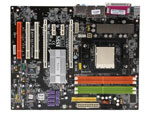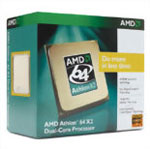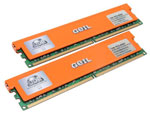Baseline AMD High-End Platform
Starting with the AMD basic high-end offering, it should come as little surprise that you still get a powerhouse of a computer for the cost. A fast processor, dual graphics cards, 2 GB of RAM, and a good amount of hard drive space will keep all but the most demanding users satisfied. We won't be putting together an equivalent Intel system, as we already mentioned, but it could certainly be done. Let's take a closer look at a few of our component choices, and discuss some of the alternatives you might want to consider.
 |
The choice of motherboard determines in a large part what sort of system you are going to build. A high-end gaming system will come with dual X16 PCI-E slots, often with full X16 bandwidth to each slot. The truth of the matter is that PCI Express graphics cards are rarely starved for bandwidth, so dropping down to X8 bandwidth won't have a dramatic impact on performance. We saved about $40 by going with the MSI K9N-SLI Platinum motherboard, which uses the nForce 570 SLI chipset as opposed to the nForce 590 SLI chipset. The motherboard won't overclock quite as far as some other offerings, and during our testing for the review we found that it seemed to hit a brick wall very quickly once you passed a certain point. If you can live with the approximately 315 MHz top bus speed "limitation", however, the board still performs admirably.
 |
Moving on to the processor, we have chosen what is best classified as a moderately fast AMD offering, the Athlon X2 4600+. When the AM2 processors first launched, the 4600+ carried a price tag of nearly $600. We didn't really recommend the processor then, but with the updated price of roughly $250 it becomes a lot more attractive. We considered recommending an upgrade to the 5000+, with a price of roughly $365, but at present many places that stock the CPU at that price are backordered. Besides, as we've already stated, Intel definitely has the performance advantage anyway, so if you're looking at getting a reasonably high-end AMD system you might as well save a bit of money. Overclocking is always an option, and we have found that most dual core AMD AM2 processors top out somewhere between 2.6 and 2.8 GHz without resorting to extreme cooling, in which case you would again be better off saving the money and getting a slightly slower stock clock speed.
 |
The choice of memory sparked some serious debate here at AnandTech, as well as a vigorous search of many vendors along with our own pricing engine in an attempt to find the best performing memory at the lowest cost possible. We mentioned this in our last midrange guide, and we will reiterate the point here:
DDR2 memory prices have skyrocketed over the past couple of months. You could find 2 GB of reasonably performing DDR2 memory for only $150 two months ago, but now the cheapest price you will find for such memory is $200, with the better performing options costing over $250. Given that our baseline AMD configuration is more of a "budget high-end" system, we tried to keep the costs down as much as possible. We still wanted to get some DDR2-800 memory with CL4 timings, however, as memory with those specifications generally marks the beginning of the high-end RAM. Our own memory reviewer relayed the following information, which is worth repeating: "Corsair, Crucial, Kingston, G.Skill, GeIL, Mushkin, OCZ, Patriot, Super Talent, and TEAM (and several others as well) have all been very competitive at the same speed grade in DDR2." Basically, if you buy memory with the same specifications, the difference from one manufacturer to another is not going to be huge. With this in mind, we looked for DDR2-800 memory with good timings and tried to find the lowest current price. As you can see, we ended up with a GeIL Ultra 2x1GB kit. If prices change in the near future and one of the other manufacturers offers DDR2-800 CL4 RAM at a better price, they would get our pick for "budget high-end" memory.
 |
Having selected an SLI motherboard, we of course chose to go with two NVIDIA graphics cards. There are many options currently available, but generally speaking we feel you should get the fastest single card you can purchase up until the GX2 before moving to dual graphics cards. In other words, we would take a single fast 7900 series card over two 7600 GT cards. Once you reach the cost of the GX2 (about $500), many new options open up. Two 7900 GT cards would have been a good choice a month or two back, but these cards have now been displaced with the launch of the 7950 GT and the 7900 GTO. The 7900 GTO is basically a 7900 GTX design, including the large, quiet heatsink/fan, only with lower memory and core clock speeds. Many people have had good results in overclocking the GTO to GTX clock speeds, but even at the stock speeds it will be a very fast card. The only drawback is that the cards are dual slot designs, and the GTO cards don't currently include HDCP support. Relative to the 7900 GT, you will definitely get better performance, as you get twice as much memory with a faster core clock speed.
A near tie in terms of getting our recommendation is the 7950 GT cards. These have a slower clock speed than the GTO but include faster memory, they take up a single slot, and you can get HDCP support. They also cost a bit more than the GTO and they make more noise. We decided to save money and sacrifice expansion slots, and with many games starting to stress GPU core performance rather than memory bandwidth we feel the GTO will be faster. It ends up being a decision between features and price, however, so you should choose whichever appeals to you more.
Rounding out our component selections, we chose to go with a single 320GB hard drive and the obligatory 16X DVD burner. In both cases, we had an eye towards performance as well as price. For 320GB hard drives with 16MB of cache, the Seagate 7200.10 is currently the lowest price and offers compelling performance. You could always go with a smaller or larger hard drive, although the difference in price between 250GB and 320GB isn't very large. With Blu-Ray and HD-DVD on the horizon, DVD burners are all becoming very similar in specifications and performance. Media compatibility will still vary, but if you get the drive manufacturer's recommended brand you shouldn't have any problems, at which point you can simply choose whichever is cheapest. Once again, that honor falls to the NEC ND-3550A, with LG Electronics, BenQ, LiteOn, Pioneer, and others following close behind. The only thing to remember is to get an optical drive with a faceplate that will match your choice of case.
We will wrap up with a brief note on the operating system selection. All of the systems we are putting together today should be fully compatible with Windows Vista once it becomes available, not to mention Windows XP, Linux, and many other operating systems. You should also be able to run either 32-bit or 64-bit versions of any of these operating systems, although the overall performance and compatibility of Windows x64 OSes at present is lower than their 32-bit offerings. You then need to decide which specific package to get within the OS family, and for Windows XP that means choosing between Home, Professional, and Media Center Edition. For anyone that runs more than a single computer on a network, we definitely don't recommend XP Home. Media Center Edition and XP Professional use the same code base, with a few minor differences. We feel MCE is the most versatile choice overall, and the fact that it is $20 cheaper helps to seal the deal. If you plan on running 4GB of memory or more, you will probably want to upgrade to a 64-bit OS, but we will continue to recommend 32-bit Windows and 2GB of RAM for the time being.














45 Comments
View All Comments
Zebo - Tuesday, October 10, 2006 - link
Anandtech really needs to start doing monitor tests again. I don't know if you used those Acers but they suck bad. And the Dell 24" suffers from serious input lag and poor view angles like the TN Acers. LCD's are not a commodity where you can graph price/size and pick your winner. Does 8 bit means nothing? Color shift? Input lag? Lying specs vs. real specs? Good viewing angles? LCD scaling for gamers?The 30" Dell is pretty decent as it's an IPS but not overdriven like the new HP so it's slow.
JarredWalton - Tuesday, October 10, 2006 - link
I've got both Dells, and they work fine for everything I do. Overdriving displays is mostly just playing the numbers game. If you can see pixel lag on any of the Dell LCDs mentioned, then you can probably see pixel lag on virtually every LCD on the market. I will be doing some LCD reviews in the near future, but so far I have far bigger issues with prices than I do with performance. I just wish I could get an LCD that ran at a high refresh rate in order to avoid tearing when vsync is disabled. Unless you do professional imaging work where having accurate color values is absolutely necessary, most LCDs will get the job done. As for the Acer displays, they did get put on the bottom of the pricing chart for a reason, and I don't think they are the highest quality displays available. They aren't the worst displays available, and without spending twice as much money it is unlikely that he will seek dramatically better performance or colors in the same size display.limiter - Tuesday, October 10, 2006 - link
I agree on the price, I bought a cheap (under $275), BenQ FP202W 20.1in Widescreen display that got panned by Tom's Hardware as the worst 20.1in widescreen monitor they've ever seen, yet I think it's great. I don't see lag, or the other problems mentioned in their review. I went from a 19in CRT so it's not like I was going from a 15in at 32ms to 8ms and that's why I think it's great. Maybe I just have bad eyes, but I'd buy it again.JarredWalton - Tuesday, October 10, 2006 - link
That's a perfect case in point. While it is definitely possible to measure differences between LCDs, the simple truth is that most people can't tell the difference without specialized hardware to measure values. For example, a display that has colors that are off by 10% might not look as good next to a display that has accurate colors. However, if you're viewing them individually in separate rooms, you're going to have a difficult time determining which is better using just your eyes. The lighting in a room often has more of an impact on the display visuals for typical users than the display itself.Howard - Monday, October 9, 2006 - link
The efficiency of a PSU has nothing to do with its actual power output.JarredWalton - Monday, October 9, 2006 - link
No, and I don't believe I said it does. It has to do with how much power is used internally in the conversion process, so a 70% efficient 600W PSU could in theory draw 857W and an 85% efficient 600W PSU would only draw 706W - something like that.I guess the text implied that the efficiency meant it could output 500W. What I meant is that it can do 500W output, and it can do it at a high efficiency. There are plenty of "500W" PSUs out there that would fail if you really tried to pull 500W from them. I'll clear up the text....
yyrkoon - Tuesday, October 10, 2006 - link
Actually, I believe its more like power thats NOT lost to heat while being converted to DC, from AC. Feel free to correct me if Im wrong though :)BigLan - Monday, October 9, 2006 - link
Given the ati-amd merger, the AMD god box uses nvidia sli while the Intel box uses ATi crossfire. I suspect that in a year that situation will be reversed.Good guide btw, it's nice to dream about building a system like this, but I'd stick with my Scythe Ninja for a HSF.
limiter - Monday, October 9, 2006 - link
How much of this hardware did you guys test together? I wonder especially about the memory and the optical drives simply because there seem to be a number of modules and drives out there that either don't work, or don't work as well as they should with the p965/975x motherboards. I'm looking at building a new system soon and really appreciate these guides, but I would like to see either confirmation that at least the memory was tested with the motherboard/processor combo listed, or that someone else has tested it and you are going off that... I guess just for peace of mind before buying anything. The motherboard manufacturers list a small number of compatible modules, ASUS being the worst.Gary Key - Monday, October 9, 2006 - link
The majority of the components have all been tested on a large cross-section of boards. Some components work better in certain boards (even though the chipsets are the same) than others. Memory was a very weak area in the P965 launch and it was not the budget memory at the time, it was the upper end memory that was having issues. My opinion on the subject matter is that both the memory and motherboard suppliers had equal issues. The majority of it has cleared up now although it is difficult to understand why certain memory modules and bios updates still have issues playing nice with each other. As far as optical drives, please let us know which one is having an issue, tried over 18 different optical drives from a Kenwood TrueX to a Pioneer Blu-ray without an issue on our current collection of 965/975 boards. At least 11 different hard drives have been used also at this time.